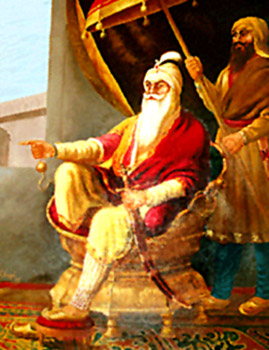 Judicial Administration of Maharaja Ranjit Singh had no written laws. Judicial decisions were made in accordance with customary principles. The judicial procedure was crude and simple and no distinction was made between civil and criminal cases. The settlement of disputes rested with the Panchayat, which was like an arbitration court. The decisions of the Panchayats were revised by Kardars whenever they were not accepted by either party. In towns justice was administered by Kardars who decided important cases within their jurisdiction. In the cities, cases were decided by Nazim or by important Kardars. Sometimes separate officials were appointed to do only judicial work and they were known as Adaltis. A distinct court was set up at the capital known as Adalat-i-Ala.
Judicial Administration of Maharaja Ranjit Singh had no written laws. Judicial decisions were made in accordance with customary principles. The judicial procedure was crude and simple and no distinction was made between civil and criminal cases. The settlement of disputes rested with the Panchayat, which was like an arbitration court. The decisions of the Panchayats were revised by Kardars whenever they were not accepted by either party. In towns justice was administered by Kardars who decided important cases within their jurisdiction. In the cities, cases were decided by Nazim or by important Kardars. Sometimes separate officials were appointed to do only judicial work and they were known as Adaltis. A distinct court was set up at the capital known as Adalat-i-Ala.
Civil cases were of different kinds. Some of them were concerned with matrimonial matters while others were concerned with breaches of contract, sales on credit etc. Great importance was attached to the sworn testimony of witness. The government levied fees on the successful party. Civil cases concerning the landed property were decided on evidences obtained from records which were regularly kept in Qazi Khanas. As regards criminal cases, the infliction of capital punishments was reserved for the Maharaja himself. Punishment for murder or other physical injuries was meted out to offenders more often in the form of fine than bodily chastisement. Mutilation was employed in exceptional circumstances. The rigour of punishment depended upon the nature of the crime, the personal disposition of the Magistrate and the likelihood of his action being reported to the Maharaja. Though to all intents and purposes the judicial system of Ramjit Singh was crude and simple, it was suited to the social and political environments of the people of the Punjab. The abuse of authority by local officials was curbed in many ways.
Maharaja Ramjit Singh had established in Punjab a pure and unmitigated despotism. He transformed the Constitution of the Sikhs from an irregular commonwealth of a loose federal type into a military monarchy based on the personal rule. Under Ranjit Singh, the people of Punjab were governed in a manner which generally suited the existing state of the society.
Village life was not interfered with. Its local affairs were mostly in the hands of the Panchayats. Under Ranjit Singh the Sikhs achieved brilliant triumphs. The despotism of Ranjit Singh may be described as benevolent. He was not an alien ruler from the point of view of race and religion. Under his authority, the economic resources were fully utilised in the kingdom. During his rule the people of Punjab evolved a degree of law and order and entered upon a period of peace and prosperity which had not been enjoyed for several generations.






































